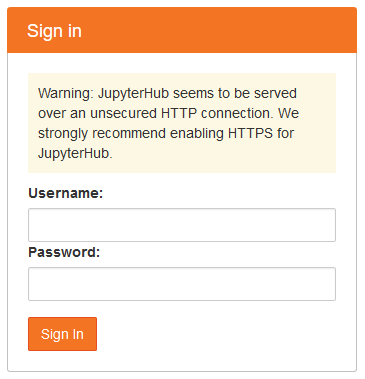Run JupyterHub as a system service
Running JupyerHub as a system service allows JupyterHub to run continously even if we aren't logged into the server. It also keeps JupyterHub running while when we log into the server and make any changes.
Create a jupyterhub.service file
To run JupyterHub as a system service (according to this wiki
), we need to create a service file in the /etc/systemd/system directory. cd into the directory and have a look around. We see a couple files that end in .service
$ cd /etc/systemd/system
$ ls
cloud-init.target.wants network-online.target.wants
dbus-org.freedesktop.thermald.service paths.target.wants
default.target.wants sockets.target.wants
final.target.wants sshd.service
getty.target.wants sysinit.target.wants
graphical.target.wants syslog.service
iscsi.service timers.target.wants
multi-user.target.wants
Create a new .service file called jupyterhub.service
$ sudo nano jupyterhub.service
In the jupyterhub.service file, add the following. Note that as part of the PATH environment variable /opt/miniconda3/envs/jupyterhubenv/bin/ is included. This is the path to our virtual environment. As part of the ExecStart= section, include a flag for our JupyterHub config file located at /etc/jupyterhub/jupyterhub_config.py.
[Unit]
Description=JupyterHub
After=syslog.target network.target
[Service]
User=root
Environment="PATH=/bin:/usr/local/sbin:/usr/local/bin:/usr/sbin:/usr/bin:/opt/miniconda3/envs/jupyterhubenv/bin/"
ExecStart=/opt/miniconda3/envs/jupyterhubenv/bin/jupyterhub -f /etc/jupyterhub/jupyterhub_config.py
[Install]
WantedBy=multi-user.target
Save and exit the nano text editor with [Ctrl-x] + [Enter].
Reload the systemd daemon and start the system service
Now we need to reload the system daemon and run JupyterHub as a system service using the command: sudo systemctl <start|stop|status> jupyterhub
$ sudo systemctl daemon-reload
$ sudo systemctl start jupyterhub
We can see if JupyterHub is running with:
$ sudo systemctl status jupyterhub
Loaded: loaded (/etc/systemd/system/jupyterhub.service;
Active: active (running)
Test local OAuth
Now we can go to the server and log in as our non-root user peter.

A couple times I thought that JupyterHub was running after using
systemctl start jupyterhub, but the JupyterHub wasn't working when I went to the server's web address. It turned out that JupyterHub wasn't running when I keyed insystemctl status jupyterhub. Most times looking for an error and tracking down the the error worked, but one time it seemed to be a problem with the http-configurable-proxy.
The following command shuts down the proxy if you get stuck like I did (insert the number corresponding to the configurable-http-proxy process after the kill command):
$ ps aux | grep configurable-http-proxy
$ kill ####
Next Steps
The next step is to have JupyterHub accept Google usernames and passwords. This allows students with college email accounts to log into JupyterHub and means we don't have to deal with creating new users and sending students usernames and passwords.